-
Posts
9,458 -
Joined
-
Last visited
Content Type
Profiles
Forums
Gallery
Events
Posts posted by cbrxxquad
-
-
I had a studded ball and on the zx tree a long bolt and collar and a forked washer. the ball and collar tightened on the fake xx top nut and the bolt went all the way through the stem and tightened on the forked washer. Would not work on the rvt tree. hole was too small. Sooo I taped the hole 3/4 11 thread and took a 3/4 bolt and drilled and taped the center the same as the studded ball and cut the head off and now the center of the hex on the top tree nut is the same as the studded ball. Screws right in.
Finished and took for a ride. Some things different. With the way the zx tree and stem is longer than the xx neck you have to use spacers, and the top tree is higher than the stock is. The forks are 1/2 inch shorter than the stock xx too. This means the front is lower all things considered. I have used the front of the faring to the ground on the centerstand to relate the diferences as it is a fixed common point. Any difference here shows in the handling.
If you don't mind Mack, being it's your thread.
The Zx tree and forks in their stock location installed in the xx neted a 4.25"
Stock xx was 5"
rc51 in the xx with the forks mounted with the same sticking out of the top tree as the zx, 5". Part of this is the fact the offset between the three trees is different. The least moves the wheel closer to the body. Reducing the trail. Right Tim? Making it easier to turn in. Not sure where the xx fits but the rc is more offset than the zx.
Now for feel, and setup. Proper sag is 30% of travel. I say real travel. Measured with a tie rap, and a real ride. When I have the front forks in the right place, I can change the preload +1 for highway travel, -1 for twisties, -2 for tight twisties. Luggage,-1. Or so.
I have all the preload out and it feels highway, till I try and turn, and it feels like twisties. Think I am going to lower it some till I get the preload right. Not to sure just yet due to the offset being more on the rc.
Thanks Mack
-
Just installed the sp1 rc51 trees.
Notes.
need a .100 spacer under the lower bearing and seal to space the tree away from the frame. It will rub and that ain't good,
cut the stops off and drilled and tapped a hole for a 8mm bolt and spacer to hit the frame stops at the bottom.
Place so it will limit and far enough away from the frame,,,neck, Not that easy to locate, but works perfect.
Had to a round the sharp edge that the lower clamp bolts seat on because they hit the ram air tubes.
Have not rode it yet so not sure how it feels.
Started this morning and just got to the point that I was almost done, just need to figure how the garmin is going to mount now. different...

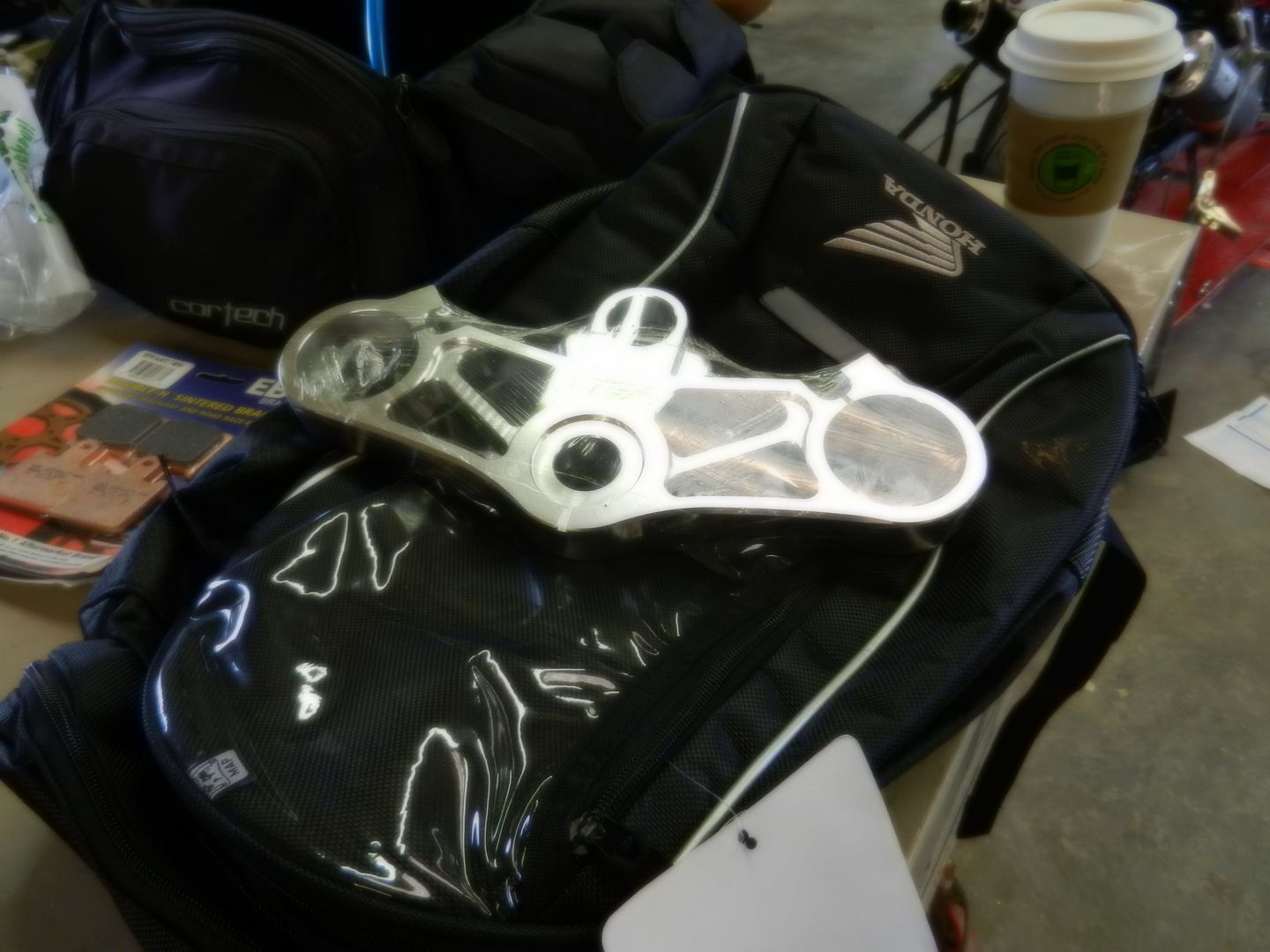
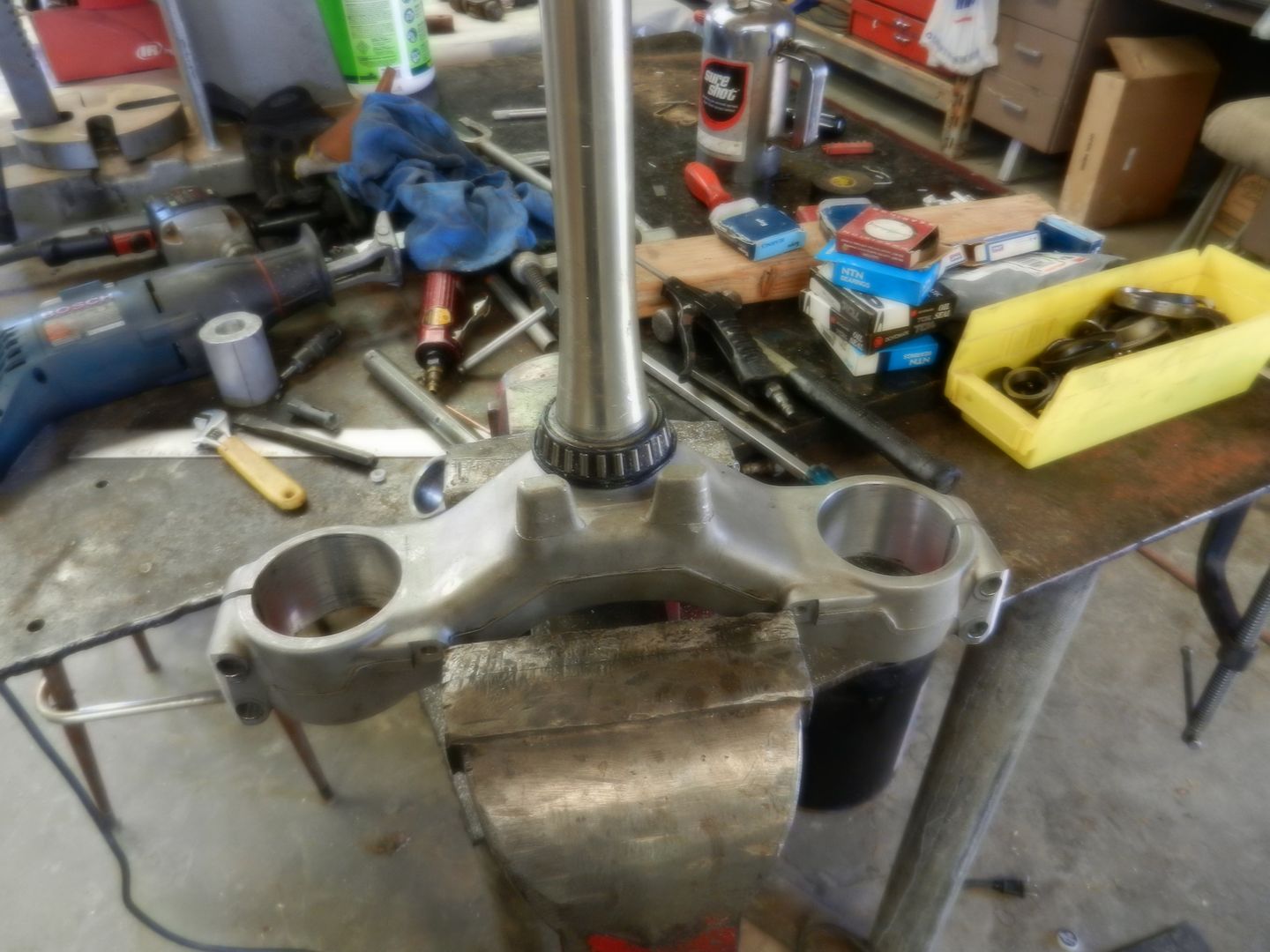
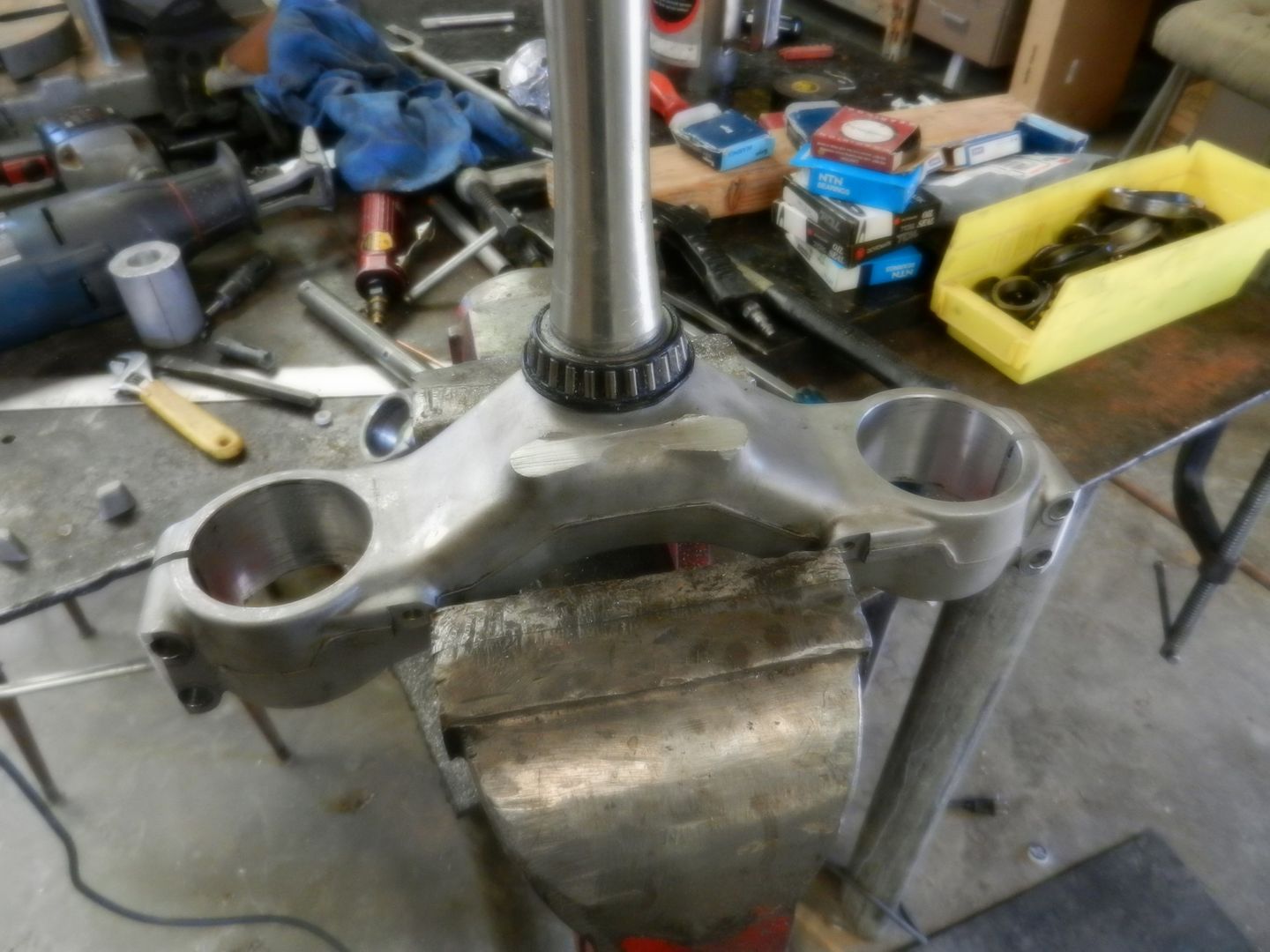
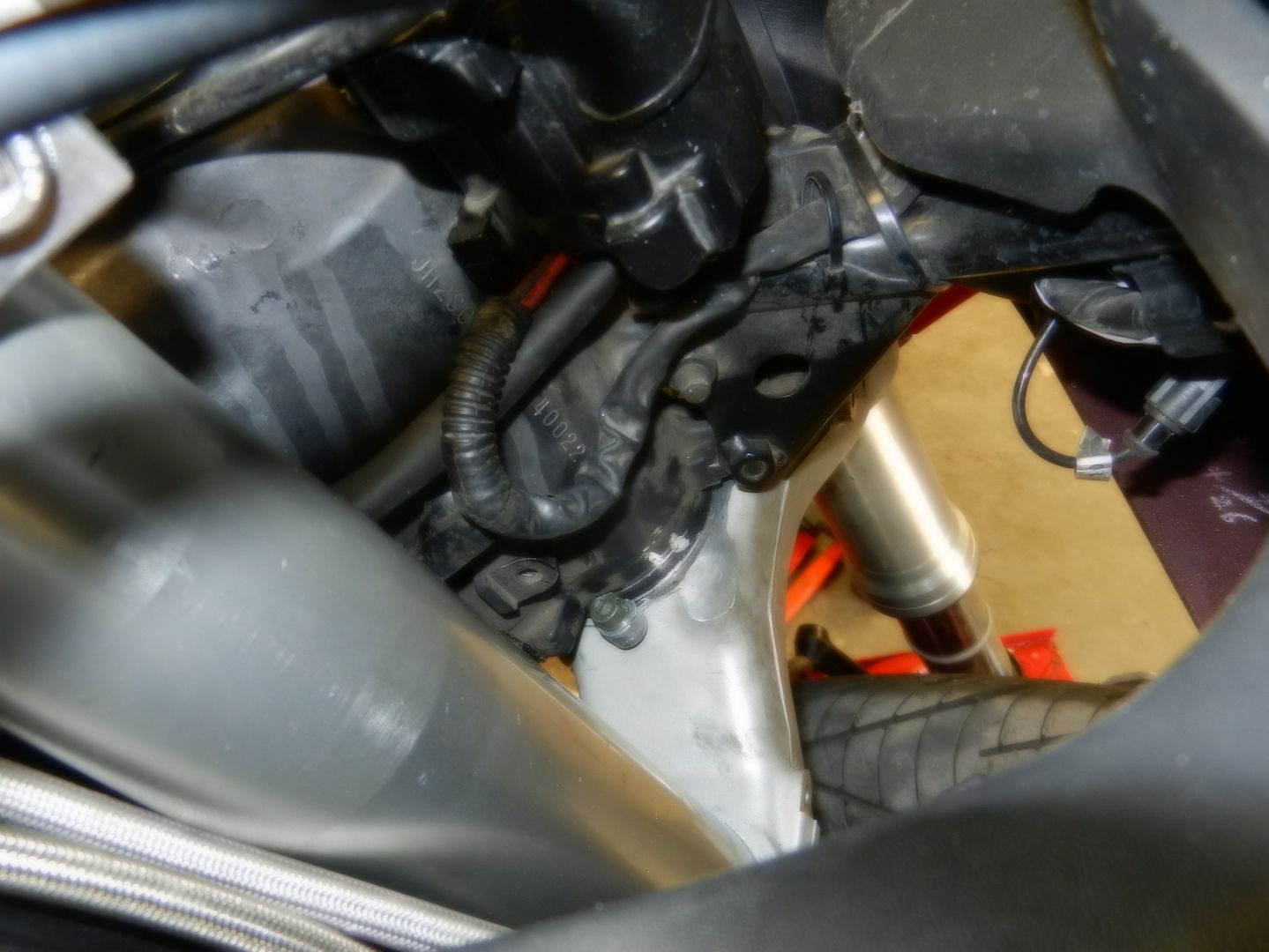
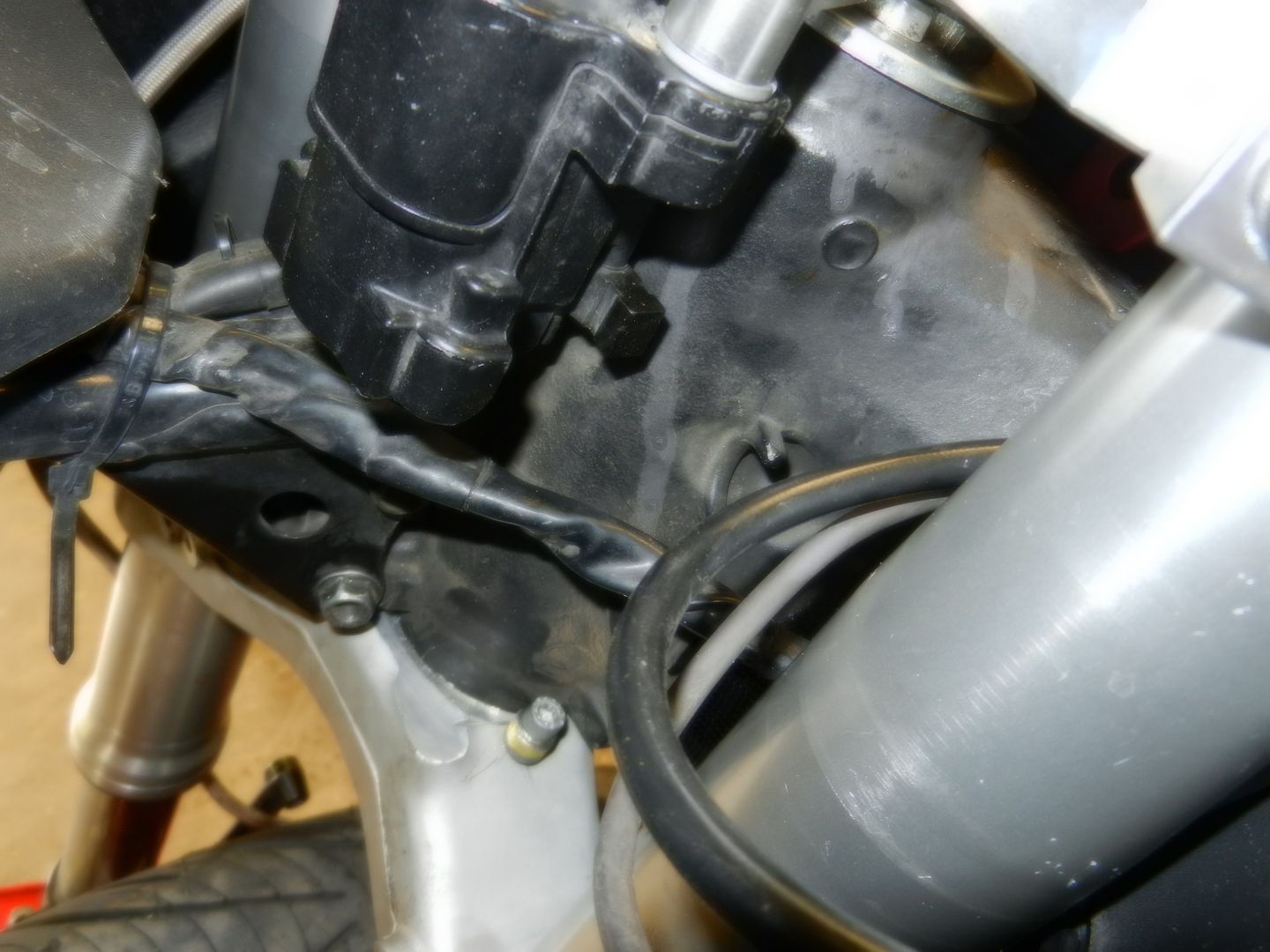
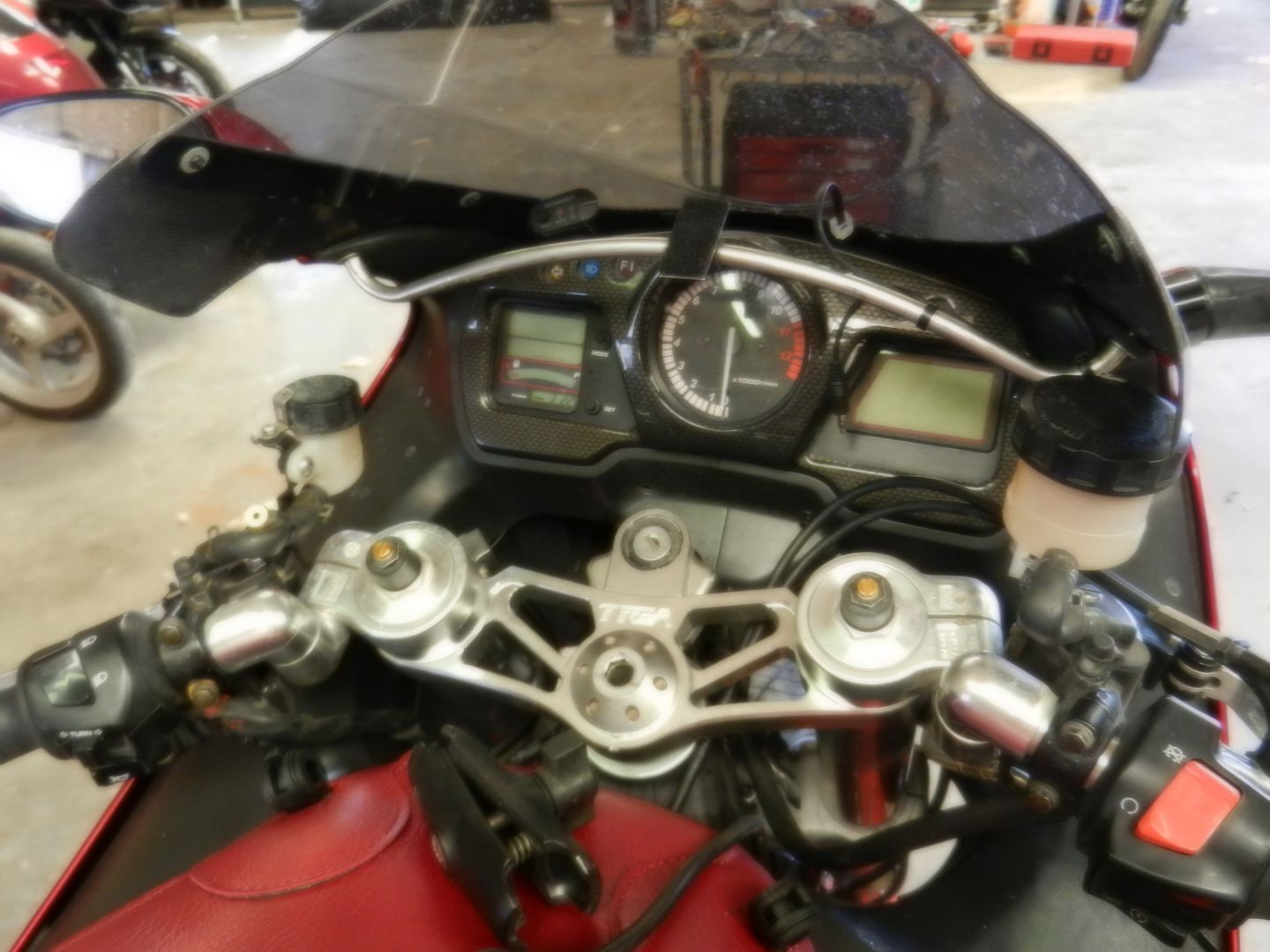
And yes the xx top nut works.
-
Great job Hank. Thanks for bringing that back. Gorgeous.
-
Should be zx10 zx 14 cause the zx12 stuff I don't know if it will work.
I have a rc51 sp1 lower comming and a after market upper ordered, still need the upper bearing, have the lower. Just to see.
Mike the stock controls, electrical, should work with the zx masters and xx throttle. The problem with the way the throttle cables come out can be repaired with a new index hole to put the cables above the lever. but I used the carb throttle cables cause they are longer. The reason the zx masters and clutch is the added volume of the four piston calibers. You might find the xx are fine though. Being the linked lines adds required volume. I found that I had to go to the larger goldwing master on the quad with the four piston radial calipers as the lever feel was not correct. I think the redial master and clutch and remote reservoirs are much better but the mounts for the reservoirs had to be modified to clear correctly.
The zx rear swing arm, is two inches longer, and the wheel,,,zx? will fit in the xx arm. If you want.
I could go on,,for ever, so I won't.
-
The bank angle sensor has to be done that way to reset it. Must turn off the key. I am probably the only one to have caused their BAS to trip on a ride. And not hit the ground. The way it works in the wiring a loose connector or shorted wire would cause it to do that. I looked at the wiring to see if I could wire around it but not able to. So I pulled the pendulum out.
Just saying.
so when your bank angle sensor cut out during a low angle turn, did it effect the rest of your turn?
Died, had to turn off the key, back on fired right up.
You may not know, this was on the blackbird quad, and was off road at the time in the sand hills, when I first built it in 2003. Being that I turn flat and does not lean, centrifugal force throws the pendulum and kills it. Same as dropping the bike.
-
Mods please delete this post.
cheers
Did you get your answers. Saw them on my phone, and was going to answer them,
If you want to talk about them call. Anytime.
-
the crank gear has a dampener gear spring loaded that meshes with the clutch basket. Takes up the slack between the gear teeth.
-
The bank angle sensor has to be done that way to reset it. Must turn off the key. I am probably the only one to have caused their BAS to trip on a ride. And not hit the ground. The way it works in the wiring a loose connector or shorted wire would cause it to do that. I looked at the wiring to see if I could wire around it but not able to. So I pulled the pendulum out.
Just saying.
-
It's been a long time but I sent one in and they fixed and returned, not bad then, price or time.
I do need to have the seat on the TSR redone and that is going to be hard. It's glued, no staples. Hate to even ask.
-
grab basket with both hands and turn and push in at the same time. Not that hard. direction to turn is.
-
Powdered Graphite works well.
+1
-
Ron Ayres has them at 263.59
Seen them for 150 complete on ebay and should have gotten them.
I would suggest less lock. Not a bad thing.
-
Want me to go get it and you can just come down and pay for it when you're ready?
See that, that is what you can't buy, anywhere, what make this the only place, that matters.
What a cool thing. Really.
-
Well, shit. This is a better solution than the machined bearing cup, and it's going to cost me a lot of money. Thanks for nothing, Mike.

Sorry!!! Maybe sell your triple on .com?

I got the RC51 upper for $25 on ebay... the 929/954 lower was about $175 though, I think (ebay also). The next project, which I might skip entirely, is roller bearings as opposed to the existing ball bearings I re-used from the 929 triple - they were in fine shape, though.
I've had a bunch of other projects that have snuck in front of this one, so I haven't done steering stops or tried out the key switch alignment yet. I swore that was going to be this week, but a TW200 refresh for a friend became more complex, as always. Maybe I can manage some time tomorrow morning.
That's as close to bolt-on as I think it's going to get - I would like to see an SP1 lower and how that fits with the steering stops before I make the lofty claim that the 929/954 lower triple is THE way to go. I wouldn't mind trying a 929/954 upper either, just to see how it looks. For now, I've invested enough in parts that are laying around the garage never to be used... the cost of "research".
I can probably get ~$200 for the ZX14 LSL top triple which means only an additional ~$350 for the RC51 LSL top triple. :icon_wall:

Shit I'm about ready to make you an adapter. Thought you would have had it done by now. You know the only thing different is the size of the hole for the stem. I could make a bushing for the LSL you have, and you get a RVT bottom. Or 29 or 58.
Things that make you go HUMMMM.
-
Stops can be made that bolt on the frame to stop at any distance required. Good idea too, just saying.
Setup, I start with the bike on the centerstand and measure the bottom of the front of the body work to ground, or just live with what I have. Sticking out as far as I have with what I got, as tall as possible. Safe.. Tie wrap around the fork tube and ride like I stole it. Measure the actual movement from seal to tie wrap, and set sag at 30% with me on the bike ballenced including all gear and baggage. Set the rear, and set the front. Put the compression and rebound in the middle on all.
Then bitch and adjust till nothing to bitch about. Front and rear should move the same in a bump, or when you push down on the seat. I have star wheels on the front preload for when I am slabing, loaded with bagage, twisties with and without bags. Each winter I go back to the center with everything. Each spring makes me if I didn't.
Savie?
-
-
Wonderful, really like your skills and adaption and innovation. Must be many more projects your involved in that would interesting to see other than blackbirds. Looks like we have a lot to talk about, so keep it coming.
-
AFRs
in The Garage
Eric is all that you need to know
-
Alright, I got just a minute.
The point to having a starting point is to try to get relative. Not setup the bike. That is something else. The numbers mean nothing but where in the tree to start. You only have so much to play with. And then there you are. I ran it at both extreme just to see. Both stock location of the forks in the bottom tree, and all the way as low in the tree as it will go. At the stock location of the bottom tree in the 14 forks, the lowest you can install the top tree, the forks stick out of the 14 bars even with risers. And the unloaded measurement of the coweling to ground was about the same. The rake was too. + or _ a degree from the stock xx. It sets the length of the forks in the trees to something like the xx. Because the neck of the 14 is much longer, but the location of the top of the bottom bearing race is about the same as the xx in this way.
more later, dinner.....
-
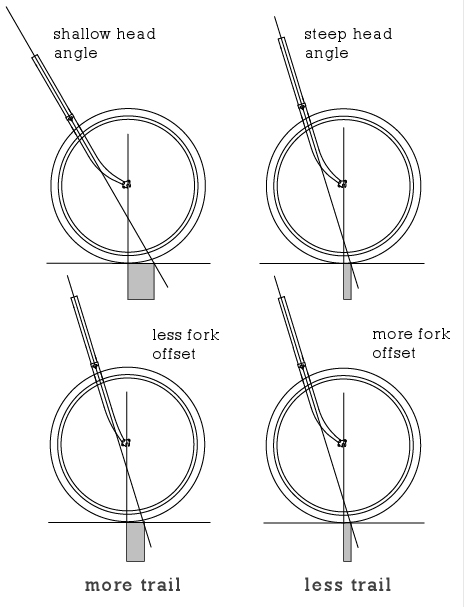 Trail
TrailThe relationship between head angle, rake and trail in a bicycle
Trail, or caster, is the horizontal distance from where the steering axis intersects the ground to where the front wheel touches the ground. The measurement is considered positive if the front wheel ground contact point is behind (towards the rear of the bike) the steering axis intersection with the ground. Most bikes have positive trail, though a few, such as the two-mass-skate bicycle and the Python Lowracer have negative trail.[6]
Trail is often cited as an important determinant of bicycle handling characteristics,[7][8] and is sometimes listed in bicycle manufacturers' geometry data, although Wilson and Papodopoulos argue that mechanical trail may be a more important and informative variable.[9]
Trail is a function of head angle, fork offset or rake, and wheel size. Their relationship can be described by this formula:[10]
where wheel radius, is the head angle measured clock-wise from the horizontal and is the fork offset or rake. Trail can be increased by increasing the wheel size, decreasing or slackening the head angle, or decreasing the fork rake or offset. Trail decreases as head angle increases (becomes steeper), as fork offset increases, or as wheel diameter decreases.
Motorcyclists tend to speak of trail in relation to rake angle. The larger the rake angle the larger the trail. Note that, on a bicycle, as rake angle increases, head angle decreases.
Trail can vary as the bike leans or steers. In the case of traditional geometry, trail decreases (and wheelbase increases if measuring distance between ground contact points and not hubs) as the bike leans and steers in the direction of the lean.[11] Trail can also vary as the suspension activates, in response to braking for example. As telescopic forks compress due to load transfer during braking, the trail and the wheelbase both decrease.[12] At least one motorcycle, the MotoCzysz C1, has a fork with adjustable trail, from 89 mm to 101 mm.[13]
[edit]Mechanical trail
Mechanical trail is the perpendicular distance between the steering axis and the point of contact between the front wheel and the ground. It may also be referred to as normal trail.[11]
Although the scientific understanding of bicycle steering remains incomplete,[9] mechanical trail is certainly one of the most important variables in determining the handling characteristics of a bicycle. A higher mechanical trail is known to make a bicycle easier to ride "no hands" and thus more subjectively stable, but skilled and alert riders may have more path control if the mechanical trail is lower.[14]
Yeah, learning a lot...
Rake Angle And SteeringTrail Causes Self-correction
By: James R. Davis
We will look at two things that result from the fact that your front forks are not pointing straight down - that is, there is a rake angle to those forks: how counter-steering is initiated and how weave and wobble are diminished.
The diagram above represents your front tire pointing to the left. The diagonal dashed line represents your steering stem as if it were extended to the ground. Please note how this defines ground trail. (The diagram exaggerates how far forward of the contact patch the steering axis point is for clarity.)
When you turn the handlebar you are attempting to turn the tire about the steering axis at ground level, not about the contact patch. For example, if you turn the handlebar to the right you are trying to get the tire to turn as shown above. However, as the contact patch is touching the ground and the axis is not, the contact patch CANNOT simply slide off to the left as shown. Instead, the body of the motorcycle moves in that direction via force at the triple-tree. You have, in effect, steered the front tire out from under the bike by steering the bike away from the tire. [At a dead stop turn your handlebars all the way to the right and observe how the top of the bike has moved to the right.]
As a result, gravity now tries to pull the bike down towards the left and that drags the front wheel with it and our travel direction has begun moving to the LEFT. (For the purists out there this is not arguing that gyroscopic precession didn't play a part - only that because there is a rake angle counter-steering would work even without gyroscopic precession.) [Note that because of the huge difference in mass between the relatively light front-end and the rest of the bike, when traveling at less than about 6 MPH you actually CAN make a significant turn of the handlebars and there is not enough centrifugal force to push the top of the bike away from the direction you are pointing to. Instead, the bike falls INTO the turn at these slow speeds and THAT is why counter-steering does not work at such slow speeds.]
Wobble and weave are diminished because when the wheel is pointing at an angle other than straight ahead the contact patch is not in alignment with the direction of travel of the bike - that is, a slip angle is created. A restoring force is applied to the contact patch by the ground which attempts to force that alignment. Thus, because of trail, the front wheel tries to go in a straight line. [This restoring force, sometimes called a 'righting moment' or 'castor effect', is a function of the length of trail. The longer the trail, the stronger it is. It is also a function of traction. The higher the traction, the stronger it is. Thus, braking increases the restoring force. This is primarily what 'dumps' a bike when the front brake is applied during a slow speed turn.]
I really want to study the geometry of countersteering
-
I am pretty sure the total length of the forks, center-line axle to top of tube unloaded are very close on the zx 14, and busa. Maybe, 3/8 to 1/2 inch shorter, which is kinda lost in the whole setup equation.
Also, I think you might be backwards on the offset thing, Tim, I have seen some pretty far offset cruiser trees, and tight racers. I ended up with the same rake as the bird, with everything set in the middle of the adjustment. I was trying to see, when I put it together, some relative point between the two to go from, so as to compare. And I left the bottom tree as it was on the zx forks when I put it together. So, the bottom bearing race, top edge, is what I found to be the only common dimension. As every thing else went together from that, all the differences showed up. Measuring some spot afterwards, that was common, left me with the resulting difference.
That is what got me to the post asking for input in the dimension from the ground to the leading edge of the lowest faring right behind the front wheel with the bike on the center stand, unloaded like that left very little variation other than spring preload. but, after riding the bike and adjusting the preload with different conditions like no luggage, both side boxes, with top box, and passenger, and all the combinations., Tight twisties to long straight slabs. How it feels turning in, and holding the corner, and picking back up. I have found that without any lift in the back from a shim, I like the front 1/2' to 3/4 lower than stock to get the adjustment to one turn either way for the differences in load and road.
If the 929 and 954 are exact replacements for the rc, hell they are cheap.
-
AH! You bought it? Highly jealous. Were it not for mini-Scott #2 on the way I'd have made a play for it.
Not yet, still waiting for the word.
-
Weather.... Rain.. Never seen adrop of water without soap in it
-
Yep same bearings....

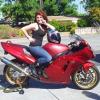
2000 Honda CBR1100XX Blackbird For Sale
in The Sales Floor -- For Sale/Wanted
Posted
Great bike and fair price. I would like to know what mods you did to get the beatles and SW motec to mount together as well as the mods to move the top box back on it. I had to modify my bags, but guess if I had to do it over, might have cut the motec out for the bags.
If you have pictures of the area you changed would do a lot.
Good luck with the sale, worth it for sure. Some may not know it, but great value.